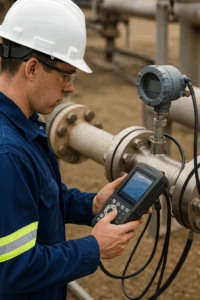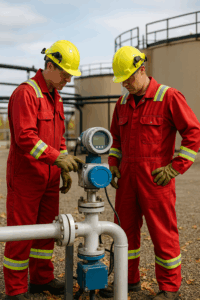Measurement That’s Built for the Field—Not the Spreadsheet
For Alberta operators, measurement is more than a regulatory task—it’s a frontline control point. Flow volumes tie directly to revenue, royalty exposure, emissions reporting, and compliance with programs like EPAP Alberta compliance. But in too many organizations, the core services that support measurement—flow meter proving, calibration, schematics, sampling—are handled in isolation.
The result? Redundant vendor visits, inconsistent records, and audit risks that show up when it’s too late to fix them.
That’s changing. And it starts with integration.
Why Flow Meter Proving Is the New Anchor
Proving used to be a checkbox. Send a crew, spin a prover, fi

le a PDF. But that doesn’t cut it anymore—not with sour service risks, tighter tolerance enforcement, and rising expectations around record
traceability.
Inline meter proving services—particularly those using regulator-approved Coriolis master meters—are changing the game. These systems prove under live operating conditions, without requiring meter removal or depressurization. They’re ideal for both gas meter proving and liquid proving, especially in upstream oil and gas environments.
While inline systems run, cross-trained field techs can recalibrate meters, update schematic drawings, validate shutdown devices, or collect samples—all during the same visit.
That’s how meter proving services become a platform—not a cost center.
EPAP Alberta Compliance Starts With Better Field Work
Enhanced Production Audit Program compliance isn’t just about back-office documentation. It’s about whether your schematics match what’s in the field, whether your proving records are current, and whether your factor a
djustments are traceable.
Most non-compliance findings trace back to poor coordination, not bad intent. One vendor adjusted a meter. Another proved it. Neither updated the flow computer. Now you’ve got a variance, and no audit trail.
That’s why more operators are consolidating around bundled field services—because integrated work means integrated records. And under EPAP, that’s the difference between proactive management and fire drills.
Proving, Calibrating, Sampling: One Visit, One Crew
 The logic is simple. When one technician can perform flow meter calibration services, complete inline or bench proving, collect gas or condensate samples, and redline drawings—your field costs go down, your data quality goes up, and your compliance exposure shrinks.
The logic is simple. When one technician can perform flow meter calibration services, complete inline or bench proving, collect gas or condensate samples, and redline drawings—your field costs go down, your data quality goes up, and your compliance exposure shrinks.
Instead of five PDFs from five companies, you get one integrated report—serialized, timestamped, and tied to your asset register. That’s what audit-ready looks like in 2025.
It’s also where centralized tools like Intricate’s Meter Maintenance Management System (MMMS) come in. MMMS schedules work, stores records, and ensures everything is locked and recoverable during audits. If you’ve ever scrambled for old proving logs during a Directive 017 review, you already know how valuable that is.
Case Study: 60 Wells, Zero Gaps, $30K Saved

A recent integra
ted program for a 60-well operator highlights how quickly the benefits stack up.
The old model relied on four vendors and two site visits per location. Many meters were still scheduled for proving—even if they weren’t in active measurement chains. Proving taps were located upstream of dump valves, requiring traditional piston provers, and sour conditions made meter removal hazardous.
Intricate deployed inline master meters to prove live. Water meters were bench-proved in parallel. Twelve reference-only meters were removed from the proving schedule after schematic review. Condensate sampling was bundled in, eliminating the need for a return trip.
Result: 25% proving cost reduction, ~$30,000 saved, and 100% audit alignment.
That’s what real field optimization looks like.
What Operators Should Ask Themselves
If you’re still running legacy processes, ask:
-
Are we proving and calibrating in one trip—or paying twice?
-
Do our schematics match what’s actually installed?
-
Are proving records automatically logged and audit-secure?
-
Can we reduce proving frequency based on asset criticality?
-
Are we still proving reference meters that no longer need it?
If you can’t answer yes across the board, it’s time to reevaluate your field strategy.
What “Integrated” Actually Means
This isn’t about buying software or adding headcount. It’s about working smarter with the crews you already need.
Bundled meter proving services aren’t just more efficient—they’re more accurate. The technicians are better aligned. The timelines are shorter. And the records are tighter.
And when regulators show up—or your CFO asks for variance reconciliation—your answers are already logged, signed, and ready.